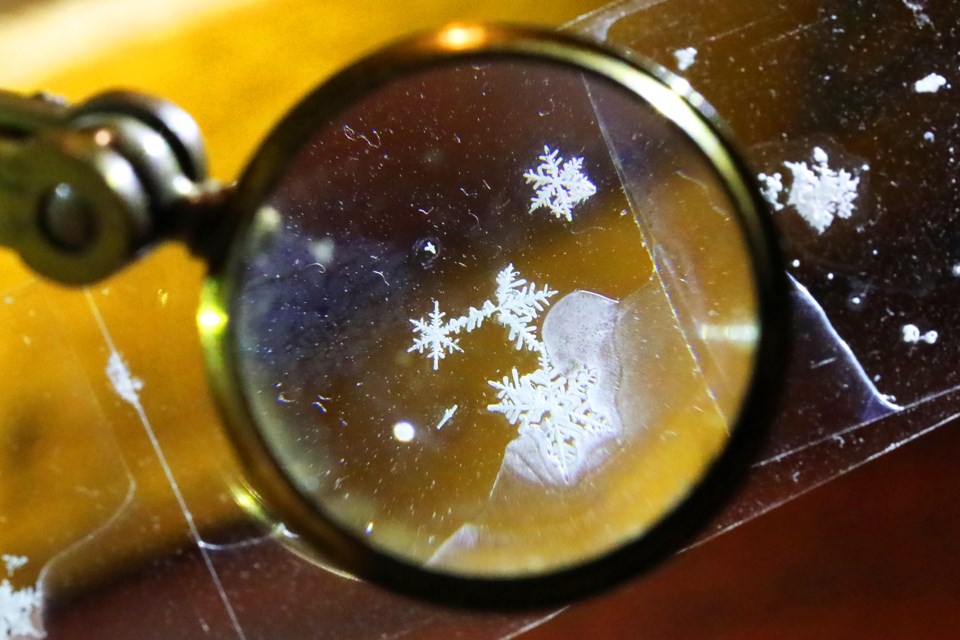BARRIE — It’s true. There are no two snowflakes that are identical. And what better way to prove this out than by preserving freshly fallen ice crystals forever and to inspect and enjoy the beauty of this natural phenomenon on your own.
This is an activity that I have been wanting to try for many years now. Having recently purchased a laboratory-grade microscope along with a 19th century one as well, the interest in the preservation of these flakes was once again on my to-do list.
The process can be very simple for most but patience is definitely key. The biggest problem is waiting for just the right conditions when mother nature creates the best snowflakes to hunt down. Most of the precipitation lately has been fairly granular in nature and not much in the way of nicely structured crystals. The best environment for collecting is when the air is still with no wind, which tends to smash and break up the crystals long before they reach the ground. On a perfect day for my first attempt, there were large, beautiful snowflakes covering the roof of my car.
You will need glass microscope slides, glass cover slips, a very fine-tipped paint brush, liquid super glue. I buy Krazy Glue as it seems to work very well (make sure to buy the liquid kind and not the gel type as it will not work properly). The main ingredient in the glue that makes all of this magic possible are the molecules in it called cyanoacrylate monomers. These little guys link together into chains with each other to form polymers which penetrate the crystals and also lock together with any microscopic forms that they come into contact with, thus taking the shape of the snowflakes. Think of it as similar to the process of how fossils are created. The end result is basically the same, just with different materials. There are also a few other chemical reactions going on here with the water in the ice, but enough with the science, let’s get back to the fun.
Before you start, all the items need to be cooled to below zero in your freezer for about 30 minutes so that they will not melt the flakes on contact. If there are a lot of small individual flakes falling, just spread the microscope slides out on a piece of cardboard or on a small foldout TV tray. They will land on the slides and most of the capturing work will be done for you. If it is no longer snowing, you will need to carefully and gently use the tip of your paint brush to lift up and move the individual ice crystals onto your slides. Once you have some on your slides you will need to put a preserving medium onto the snowflakes. Slowly and carefully put a couple of drops of the liquid glue on the flakes. I recommend that you only put the drops on one slide at a time as you need to carefully and quickly place the glass cover slip on top of the drops of glue that contain the crystals. And as a word of caution: Try your best not to get the glue on your fingers as it is superglue after all. This is easier said than done. Trust me. When the cover slip is in place, set the slide down on your tray or cardboard and move on to the next ones and repeat.
Once all are finished and you are ready to bring them into the house, you will have to be quick with getting them into your freezer before any melting occurs as you want to preserve as much of the crystal structures as possible. I usually bring a couple of plastic containers outside and put the finished slides into these for the quick transfer to the freezer. The not-so-hard work is now done. Just leave them undisturbed in your freezer for two or three days to ensure that the glue has cured fully. And that’s it! Once you pull them out and they reach room temperature after a few minutes they can then be easily viewed through a microscope, loupe, magnifying glass or photographed with a macro lens.
You can find a nice little mini-microscope for around $12 at the Mastermind Toys store on Bayfield Street. It has some pretty good LED lighting and optics. Keep in mind that this is a hit-and-miss process. There will be more throwaways than keepers as far as the best slides with the best preserved snowflakes, but the results are absolutely fascinating and are now permanently preserved for decades of viewing pleasure.
— BarrieToday.com
